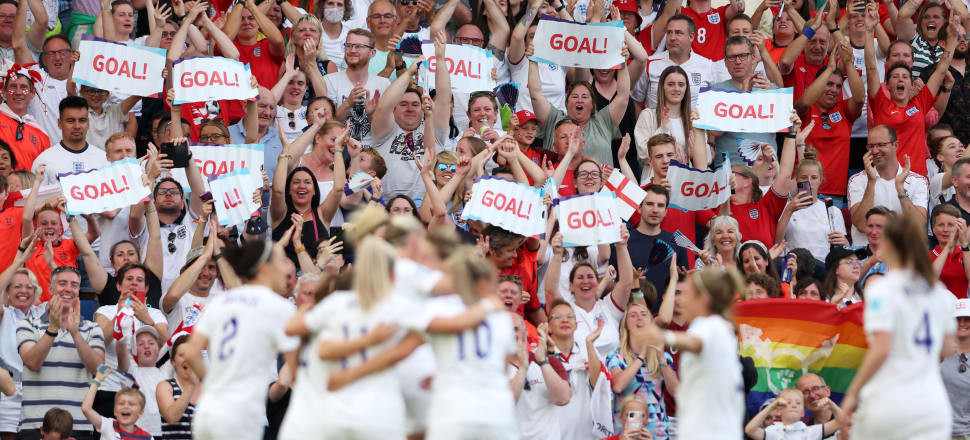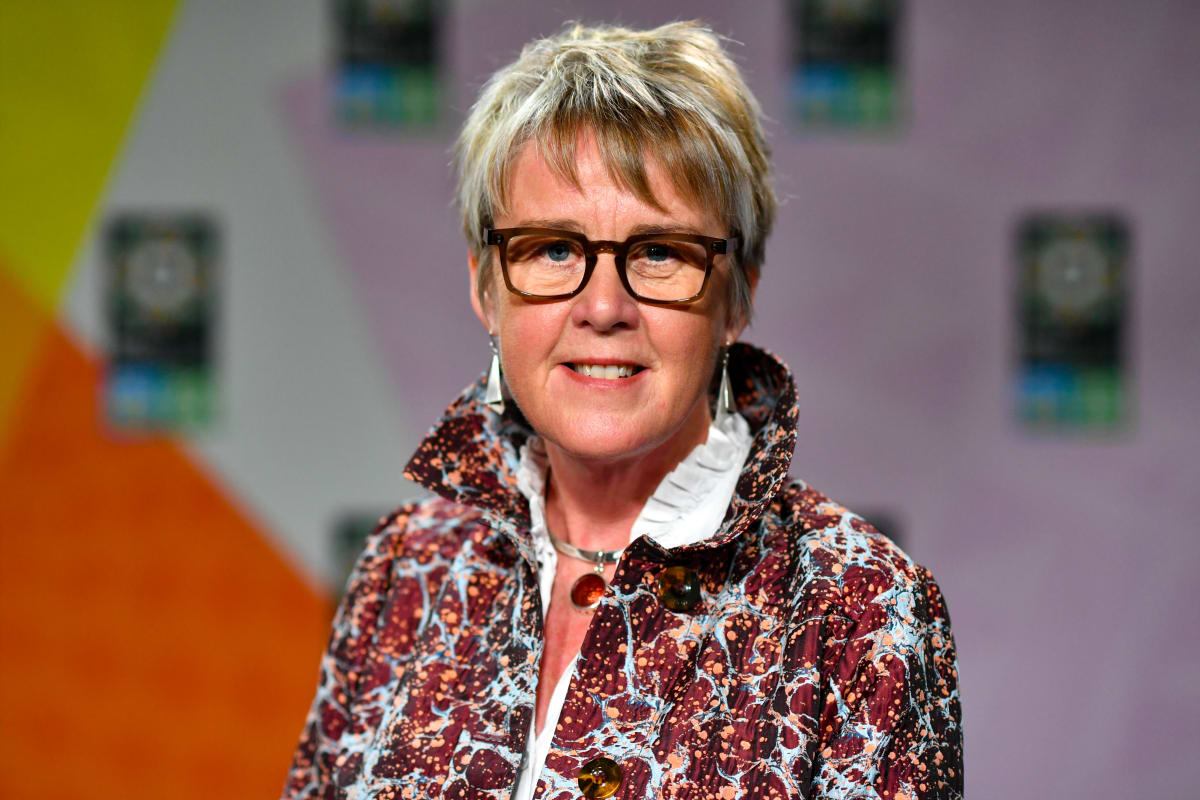
Exactly one year out from kick-off in the FIFA Women's World Cup, record crowds for the women's game globally bode well for NZ drawing fans to the world's largest female sports event. And, ultimately, inspiring more Kiwi girls to play football.
As Jane Patterson sat among the 31,000 fans in Brighton last week, watching England’s Lionesses thump Norway 8-0 in the Euros, she was imagining she was back at Eden Park.
A little girl sat next to her with English flags painted on her cheeks. A man in the row in front spent much of the game on his feet: “He was a really proud English fan; he knew his football.”
Where she’d expected the sell-out crowd to be predominantly female, it was more a 60-40 women-men ratio. “It was a real family environment, with mums, dads and kids,” she says.
It was a valuable insight for Patterson, New Zealand’s chief operating officer for the FIFA Women’s World Cup 2023, which is now just one year away from the opening game at Auckland’s Eden Park on July 20.
“I was sitting there, putting myself into the position of a fan at Eden Park on opening night – a sold-out crowd of international fans and Football Ferns fans, all singing and cheering,” she says.
It reassured Patterson that it can be done; that women’s football can attract huge crowds. And she's confident the rapid increase in interest in the game globally will have a flow-on effect for the success of next year’s World Cup, split for the first time between New Zealand and Australia.

“The game globally is being lifted, and whether or not you’re a footballer, your attention is being drawn to the fact that 68,000 fans went to watch the opening of the Euros at Old Trafford,” she says (England beat Austria 1-0 in front of a women’s Euros record crowd of 68,871).
It’s a phenomenon happening around the globe this year, since sports stadiums reopened to the masses.
In March, 91,000 football fans packed into Camp Nou, one of the biggest stadiums in the world, to watch home team Barcelona beat Real Madrid, 5-2, in the Women’s El Clasico. Then in April, the first leg of the Women's Champions League semifinal between Barca and Wolfsburg at the same ground sold out in just over 24 hours. The 91,600-strong crowd was a world record for attendance at a women’s football match.
France also had an unprecedented 43,000 fans come to Parc de Princes to watch another Champions League semi, while a friendly match between Sweden and Brazil last month filled a record 33,000 seats at Friends Arena in Stockholm.
And just yesterday, the largest African crowd to watch women’s football - 45,000 - was recorded in Morocco for a semi in Africa’s Women’s Nations Cup.
A record crowd watched Morocco beat Nigeria Super Falcons on penalties in the WAFCON semifinal.
“Every one of those little girls with their flags and their faces painted at the England-Norway game will ask their parents if they can play the game now. It’s infectious,” says Patterson.
Her mission is to now get New Zealand girls pouring into our stadiums next year.
Patterson understands a large part of that challenge is making the home side, the Football Ferns, more visible over the coming year.
The problem is the Ferns haven’t played in front of a home crowd since June 2018, when they lost to Japan in Wellington; before that, it had been over three years since they took the field in New Zealand.
That’s why the Football Ferns playing three friendlies at home next February, alongside the intercontinental play-off tournament (determining the final World Cup finals), is crucial to raising their profiles.
“I’d love to think New Zealanders not only know who the Football Ferns are, but they can actually name the players and can visualise who they are having seen them play at home,” Patterson says.
Young Football Ferns defender Claudia Bunge knows only too well the impact of watching females playing international football on home soil.
She was a young, impressionable teen in the crowd when the first U17 Women’s World Cup was played in New Zealand in 2008.
“I played a lot of sport growing up, but the real change for me was when we hosted the U17 World Cup,” 22-year-old Bunge says. “I got to see the likes of Rosie White, and other girls who are in the Ferns now. Seeing girls not too much older than me playing international football was so awesome, and it was when I decided ‘This is what I want to do’.”
Bunge has since played at the U17 and U20 World Cups, and the Tokyo Olympics (although her parents are yet to see her play in the Football Ferns jersey). Returning for her third A League Women season with Melbourne Victory, she’s also just become the latest athlete on the Team Visa roster, which champions some of the world's top athletes, including the next generation of female footballers.
“Hopefully that can help me to propel the game forward, especially in New Zealand, where it’s not as popular as it is in Europe,” she says. “I’m optimistic that off the back of the World Cup we’ll see a lot more girls, and boys as well, participating in football.”
Football Fern Claudia Bunge and Matilda Sam Kerr during Australia's 2-0 series win over NZ in April.
Explaining the magnitude of this tournament to Kiwis is a challenge too, says Bunge, who’s just arrived home from playing internationals against Norway (a 0-2 loss) and Wales (a scoreless draw).
“The World Cup is massive - it’s the biggest sporting event for women in the world. People should be really excited for what’s about to happen,” she says. “In time, people will start to wrap their heads around it and hopefully get behind it.”
Enticing international football fans to New Zealand shouldn’t be a problem. It’s estimated - global pandemic allowing - around 25,000 international visitors will come to watch 16 nations in the group games hosted here, as well as two quarterfinals and a semifinal.
Just who’s in those groups will be determined when the draw is carried out in Auckland on October 22.
The eyes of the world will be trained on New Zealand and co-hosts Australia, too. The last Women’s World Cup in France three years ago had more than 1.12 billion broadcast views (compared to 480 million for the 2019 Rugby World Cup in Japan) and 82 million people watched the final.
And the tournament is larger this time - increased from 28 teams to the best 32 nations in the world.
It’s part of New Zealand Football’s legacy from this tournament to grow the women and girls’ game here. Their target is 7 percent year-on-year growth in participation numbers, and upgrading facilities at football grounds (with New Zealand government funding) so females have better lighting on training fields, better playing fields and gender-equal changing rooms.

Giving Kiwi women a professional pathway in football was fast-tracked last summer when the first Wellington Phoenix side played in the A-League Women across the Tasman.
It all dovetails with FIFA’s investment in the women’s game, spending $US1 billion to double the number of women and girls playing football around the globe to 60 million by 2026.
Simply putting lights at training grounds hosting the 16 teams for the World Cup is massive, Patterson says: “That’s one of the greatest things that hold young women back from playing.”
There are grounds, like Eden Park, where those upgrades were made ahead of the Cricket World Cup earlier this year, and will also benefit the Rugby World Cup here in October.
For Patterson, the legacy of the FIFA World Cup is also about growing the profile of women off the pitch. “To have more women around the boardroom table, more women in administration and more women volunteering - that’s as important as growing the playing numbers,” she says.
A year out - celebrated in Hamilton this morning with a dawn lighting ceremony - and Patterson is happy with where the tournament’s planning is at.
“I look at the year that’s gone, and we announced our match cities, launched the logo, announced the play-off tournament and the date of the draw,” she says. There's the call for volunteers (5000 between the two countries) in September, before tickets go on sale in October.
“Our plan is on target, even though we’ve had delays because of Covid. It’s interesting, people think because the tournament is in 2023, the pandemic hasn’t affected us. But it has, just in different ways.”

Patterson is grateful for the ongoing help she has from the Big Four - the other three Kiwi women leading the cricket and rugby World Cups and the IWG World Conference on Women in Sport, in Auckland in November.
They try to meet for a drink and a chat once a month, and have a WhatsApp group where they are constantly sharing information on running a global sports event, Patterson says.
An interesting concept that’s grown out of the unique sharing arrangement is ‘The Bench’ - created by Cricket World Cup CEO, Andrea Nelson. Heading into the final in Christchurch, when an easing of Covid restrictions finally allowed a full house of fans, Nelson set up a reserve bench of event organisers in case any of her key people went down with the virus.
Patterson was on the bench alongside a number of her staff. “We gave her our venue manager from Dunedin for a week to help her out,” she says.
When the women’s Euros are over, the FA (England’s Football Association) will share the challenges they've faced with Patterson’s World Cup team. “The industry can only get better through sharing and planning," Patterson says.







